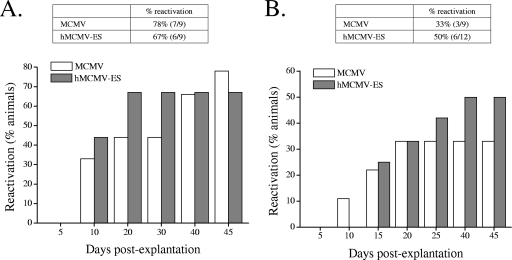FIG. 4.
Reactivation of hMCMV-ES virus. Groups of 9 to 12 3-day-old BALB/c.ByJ female mice were i.p. inoculated with tissue culture-propagated hMCMV-ES (5 × 104 PFU per mouse) or the parental virus (5 × 102 PFU per mouse) and maintained for 4 months to establish latency. Animals were sacrificed and their spleens, lungs, and salivary glands harvested. Reactivation was examined from spleens and lungs, which were manually minced and placed with medium in wells of a six-well plate. Cultures were kept (with fresh medium addition when required) for 50 days. Every 5 days, part of the supernatant was transferred to MEF monolayers (a centrifugal enhancement of infectivity step was included) for detection of infectious virus. Graphics show the cumulative frequencies of reactivation events over time from spleen (A) and lung (B) explants. The percentages of reactivation accumulated at day 50 postexplantation are indicated in the corresponding tables, with the number of positive mice versus the number of total animals per group shown in parentheses. The identities of the reactivated viruses (which differ within groups in the sizes of the HCMV and MCMV enhancer regions) were confirmed by PCR analysis using two primers that bind to viral sequences flanking the MCMV enhancer and as template viral DNAs from the indicator MEF cultures when a cytopathic effect was reached (data not shown). In addition, PCR products from a representative sample of each group and organ were cloned and sequenced. Salivary glands were analyzed to ensure the clearance of infectious virus at the time of explantation by sonicating them as a 10% (wt/vol) tissue homogenate and subsequently transferring them to MEF monolayers. Data shown correspond to results from one of two independently performed experiments in which comparable results were obtained. Percentages of reactivation between MCMV and hMCMV-ES were not statistically different, as determined by the chi-square test (two-tailed).

